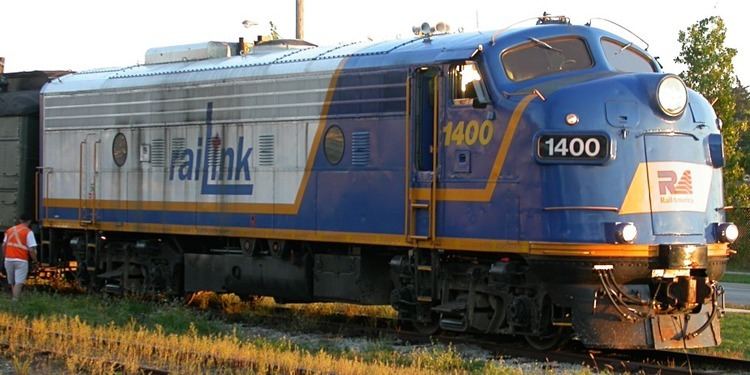Power type Diesel-electric Total produced 90 | Model FP9 AAR wheel arr. B-B | |
 | ||
Build date February 1954 – December 1959 | ||
The EMD FP9 is a 1,750 horsepower (1,300 kW), B-B dual-service passenger and freight-hauling diesel locomotive that was produced between February 1954 and December 1959 by General Motors Electro-Motive Division, and General Motors Diesel. Final assembly was at GM-EMD's La Grange, Illinois plant, except for Canadian orders, which were assembled by Canadian subsidiary GMD at London, Ontario. The FP9 was essentially EMD's F9 locomotive extended by four feet to give greater steam generator and water capacity for hauling passenger trains. A total of 90 cab-equipped lead A units were built; unlike the freight series, no cabless booster B units were sold. Regular F9B units were sometimes used with FP9 A units, since they, lacking cabs, had more room for water and steam generators. The FP9 and its predecessor, the FP7, were offshoots of GM-EMD's highly successful F-unit series of cab unit diesel locomotives.
Contents
Identification
Just as in the previous FP7, the FP9's carbody is essentially the F9's with 4 feet (1.22 m) extra added a little behind the cab, just aft of the forward truck. Unlike the FP7, the forward porthole window is relocated so that it is better balanced in the space, but there is still more room between the porthole and the first carbody filter grille behind it; it is just less obvious. As on the F9, there is now a carbody filter grille before the window as well.
FP10
FP10 locomotives are not the linear successors of the FP9, as their designation might indicate. The FP10 units were 'built' in the late 1970s by the Illinois Central Gulf Railroad at its Paducah, Kentucky shops for the Massachusetts Bay Transportation Authority using former Gulf, Mobile and Ohio Railroad F3 and F7 units. These F3 and F7 locomotives were used by the GM&O and ICG (for a short period) in Chicago-area commuter service and later in freight service until their retirement.
The rebuilding by ICG saw all of the units gain full-length stainless steel air intake grilles, which in many cases replaced the 'chicken wire' appearance which many had during their tenure with the GM&O and ICG. They were also equipped with a 480 V HEP generator at the rear of the locomotive, as well as dynamic brakes, and had their classification lights replaced with large red marker lights which enabled the locomotive to "carry the markers" when operating in push mode.
The FP10 units were never extended beyond their original length, thus making the "P" in their designation misleading. The FP10 designation, like that of the GP10 (also an ICG product) was conceived by ICG and was never sanctioned by EMD, though railroads and rail enthusiasts alike agree on the moniker.
The FP10 locomotives were painted in the MBTA's purple, silver, and yellow scheme, wearing two variations (one which had two substantial yellow swaths on the nose, and the second which used the yellow only as striping on the nose, as well as the rest of the carbody) of the transit agency's dress. At least one was painted in a scheme that was a "negative" of the conventional scheme, where purple was the primary color and silver taking a secondary role.
During the early 1990s, the FP10s were retired by the MBTA, with four being sold to the Metro North Commuter Railroad (MNCR 410-413), some leased (Cape Cod Central—and eventually resold after that operation ceased) and others being scrapped. In late 1999/early 2000, the last remaining MBTA-owned FP10 units were sold and have operated in Maryland, New Orleans, Georgia, and Idaho on various tourist trains.
